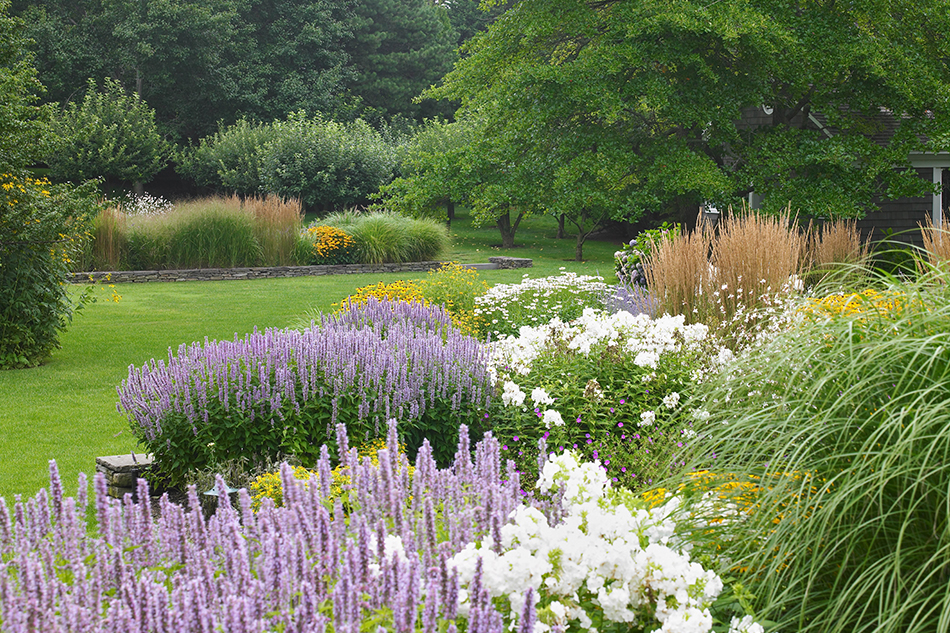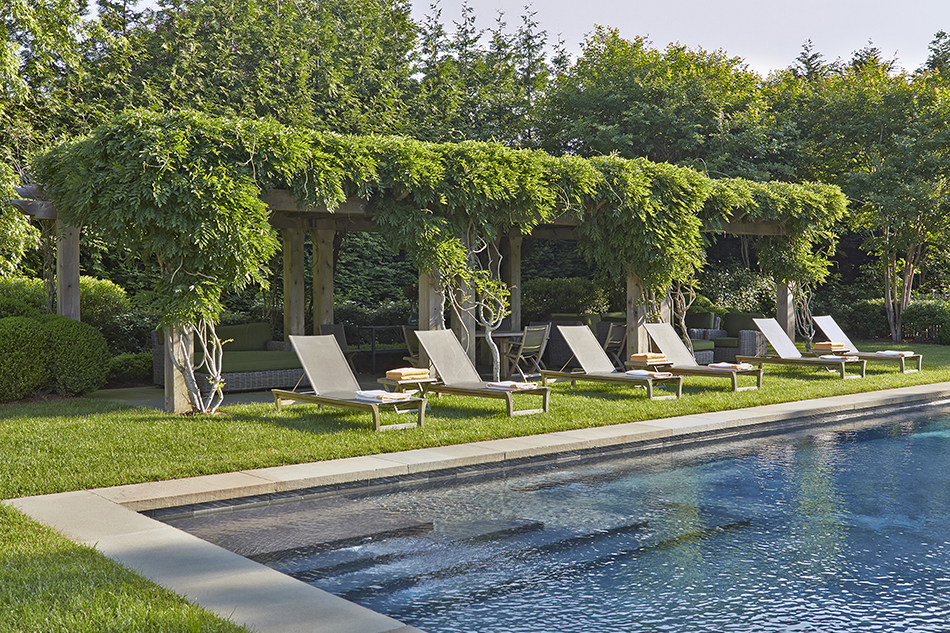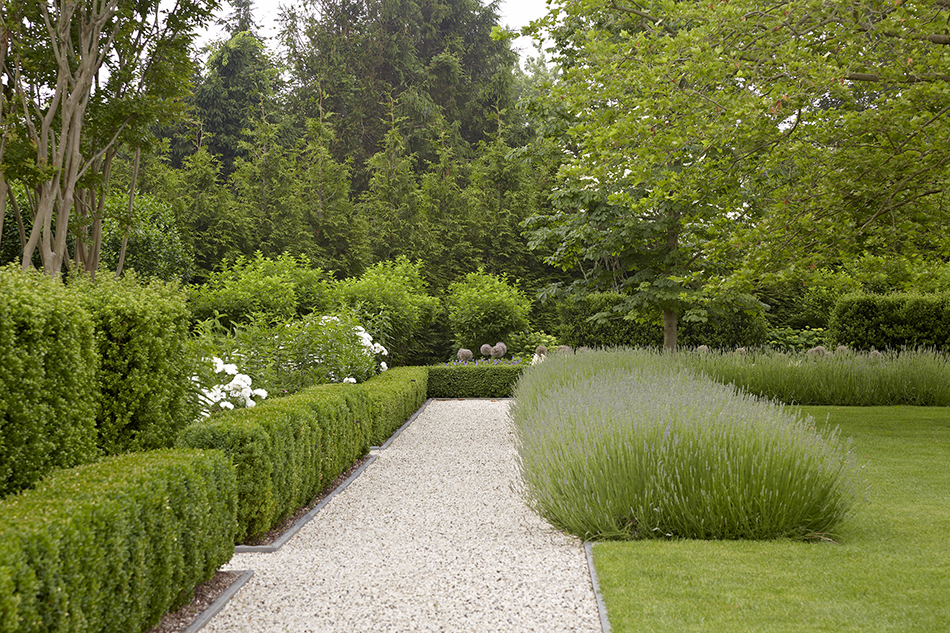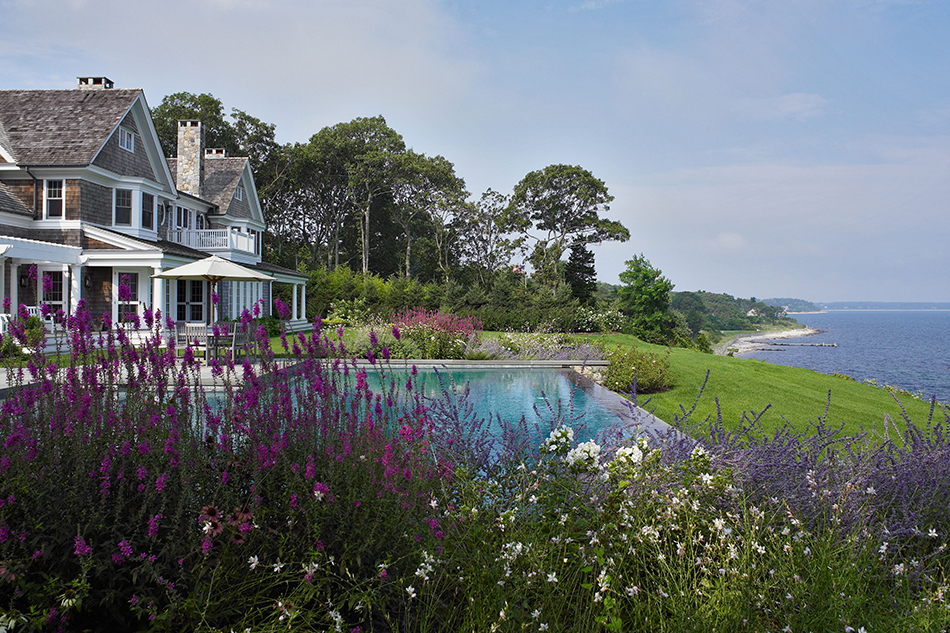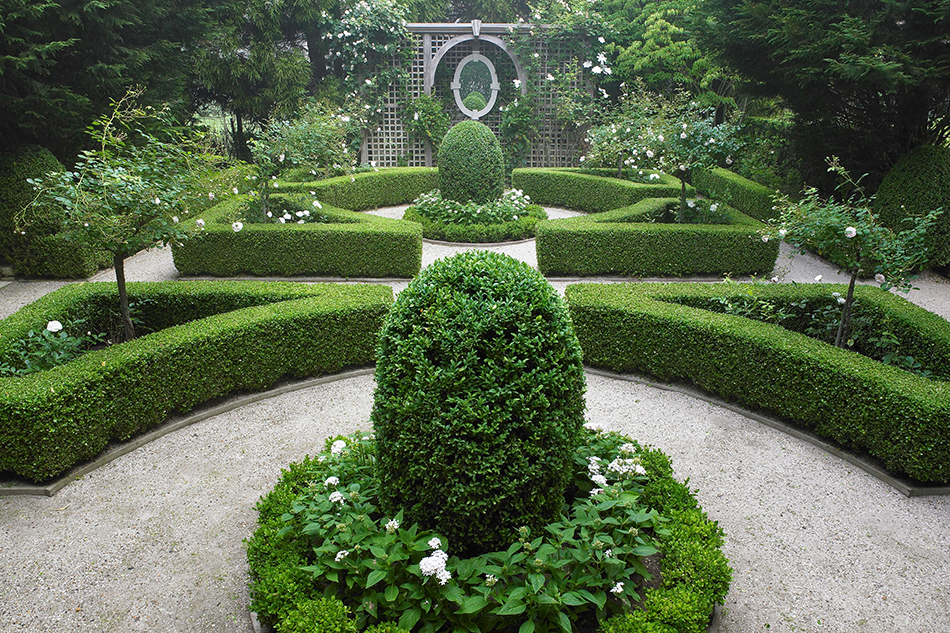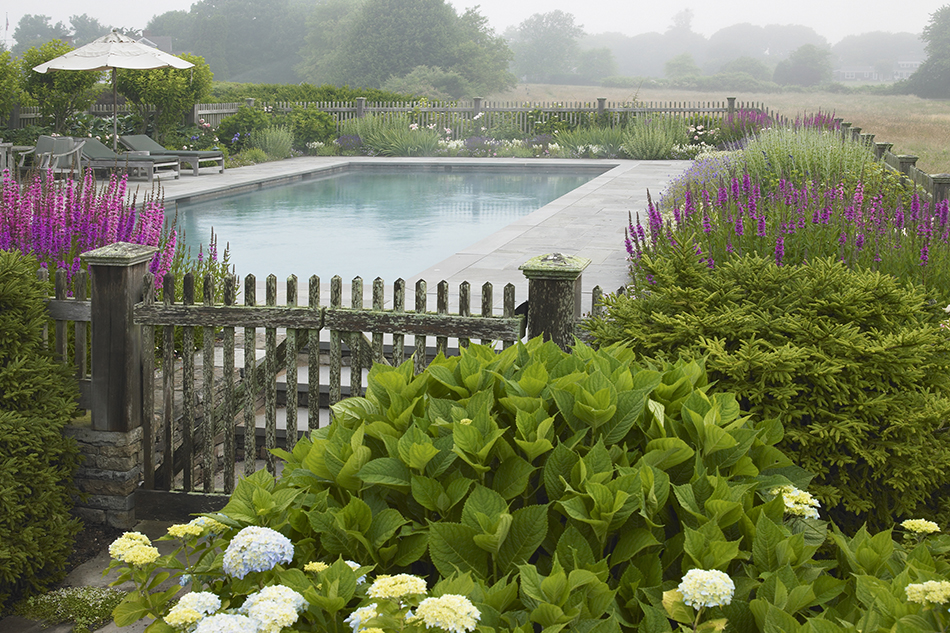
July 20, 2015“Once you step onto a piece of land, a story and a choreography should take you to the front door,” landscape designer Ed Hollander says in a new book about his work, which here includes framing a Long Island garden path with a repeating arrangement of blue and white Campanula. Top: A footpath made of blue stone crossing a reflecting pool creates a sleek, serene entrance to an East Hampton home. All photos by Charles Mayer, courtesy of The Monacelli Press
When Ed Hollander and his business partner, Maryanne Connelly, asked me to help write their book, Good Garden: The Landscape Architecture of Edmund Hollander Design, published in June by The Monacelli Press, I didn’t hesitate to say yes.
These two landscape architects had served as ever-patient mentors in my early days of garden writing for Newsday, on Long Island, when I hardly knew a perennial from a petunia, and later for the New York Times, when I was stretching out into writing about public parks, environmental restoration and landscape architecture. No question was too small. No time too busy.
Apart from loving their irreverent New York humor and wicked storytelling, I like their work. Each landscape is suited to its natural features: topography, soils, hydrology, forces of wind and sea. Every design enhances the architecture of the house and built elements, whether a grand old shingled manse with a wraparound porch on the outskirts of Sag Harbor, or a minimalist beach house overlooking the dunes in Southampton.
Their landscapes begin at that first entrance to a home off the road, be it a quiet drive through an old apple orchard (a ghost of the property’s agricultural past), or a quick turn into a forecourt of clipped hornbeam, magnolias and boxwoods, which extend — yet soften — the low horizontals of a contemporary house.

Drawing on the misty light of the ocean, Connelly and Hollander lined an îpe-wood Hamptons boardwalk with gray- and purple-hued dune plantings of cape beach-grass and wind- and salt-tolerant perennials, including Russian sage, catmint and sage.
“It sounds like Shirley MacLaine, but you have to listen to the land,” Hollander said on one of our first mornings at their office on Union Square. His little dog, Freddy, a rescued schnoodle, and Ellie May, Connelly’s aging Jack Russell, snoozed under the desk. Young designers — 14 or so work here at any one time — came and went with drawings, plant lists, messages from clients.
Since the firm’s founding in 1991, Edmund D. Hollander Landscape Architects has created hundreds of gardens, both public and private, most within 200 miles of the city. It all began back in the 1980s, when Hollander and Connelly were graduate students studying landscape architecture at the University of Pennsylvania. It was a heady time at the school, when original thinkers like Ian McHarg, A.E. Bye and Laurie Olin were challenging their students to learn every aspect of natural systems, as well as how people live in a particular place.
One day at Penn, Hollander, a plant geek who had identified every tree on the Vassar campus for his senior thesis, and then earned a certificate in horticulture at the New York Botanical Garden, strolled over to the rangy blonde drawing furiously in her sketchbook. He pointed to the open pages in her plant book and said, “Pick any plant; I’ll tell you what it is and anything you want to know about it.” Connelly looked up and said, “God, you’re an asshole.”
But he really did know his plants. “And Maryanne can draw like the wind,” says Hollander.

Hollander always seeks to create harmony between landscapes and their architecture; here, concentric turf stairs — practical for areas receiving only occasional use — lead elegantly but subtly up toward the house.
The two have forged a lifelong career and friendship over that mutual love of plants, as well as a talent for holistic design and the ability to maintain their integrity in a field that caters to the infinitely rich. (“We do have our limits,” says Hollander, who turned down a commission from one of the Koch brothers. “Maryanne told me she would quit.”) They are close collaborators, constantly conferring with each other — and while they work on some projects together, they pursue others separately. Connelly, for example, heads many of their ventures in Connecticut, with Hollander conferring, and he takes the lead on many of the Hamptons projects, soliciting her input.
For the months we were working on the book, we three spent a few hours every week talking about the essence of good design. I turned on my tape recorder and listened as Hollander clicked through hundreds of photographer Charles Mayer’s gorgeous digital images and he and Connelly talked about moving through a landscape: the sense of a journey created by curving paths, light and shade, a few wide steps up to a terrace, a zigzagging boardwalk through a marsh. They told whole stories about the placement and scale of trees.
Hollander and Connelly know the genius of a place. When they saw four craggy old catalpas — considered messy weed trees by most landscape architects — towering above a great Victorian mansion overlooking Sag Harbor Bay, they knew they should move the house, not the catalpas, so that architecture and trees could be more distinct, yet complement each other. And they did move it: literally. They recognized that the overgrown meadow that approached the house was a remnant of the Hempstead Plains, the native grasslands that once covered 40,000 acres of Long Island, and they brought back the broomsedge and little bluestem that once flourished there.

The arching limbs of Leyland cypress and low walls of Japanese holly that line these stone steps contribute to a compelling sense of progression and drama.
There may be a surfeit of blue and white mophead hydrangeas in their projects, but these old-time plants suit the architecture and cultural history of the East End’s big shingled houses with their wraparound porches. That’s what’s fun about a Hollander design: It’s unabashedly traditional one moment — and it breaks the rules the next.
For instance, they may plant an allée of Natchez crepe myrtles marching down to a Hamptons beach because these icons of such Southern cities as Charleston and Savannah are tolerant of salt winds and lean soils. Or they may use a single London plane tree, with its high spreading branches, as an airy ceiling for a summer terrace. And they’d be loath to bulldoze a cluster of wild cherry trees, their trunks and limbs sculpted by the wind, as other designers might do in order to create an uninterrupted lawn. Instead, they treasure the grove as a remnant of the native landscape, lending a sense of place to a new house that’s set behind the dunes.
One summer day toward the end of our discussions, Connelly and Hollander led the way to a grove of native tupelos, or Nyssa sylvatica, on a property they’d worked on for years on the edge of East Hampton’s Georgica Pond. They had found the trees here growing wild, covered with vines.
“We only had to pull a lot of shit off them,” said Hollander, in his typically modest fashion. But, as it was quickly revealed, their work there was in fact much more thoughtful and nuanced that that: They had also designed a meandering boardwalk through this little woods, leaving a hole here and there for a tupelo to grow through and introducing an element of pacing, drama and surprise. Mallows bloomed in the marshy soil; the dappled light grew brighter as we reached the end of the boardwalk — and only then did we see the quiet water, where a little boat waited to be sailed across the pond.

